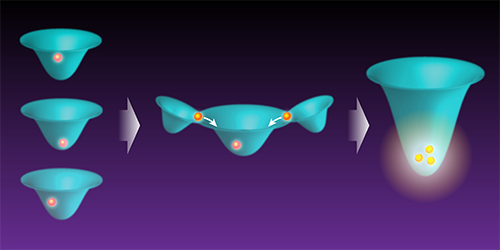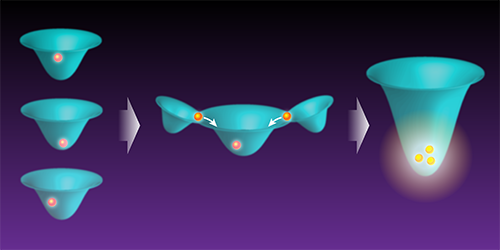Watching Three Atoms Collide
When three atoms interact, one possible outcome is that two of the atoms collide to form a molecule while the third gets a “kick” of energy as a result. This process, known as three-body recombination, occurs everywhere from laboratory plasmas to star-forming gas clouds, but despite its ubiquity, it had yet to be directly observed. Now Luke Reynolds at the University of Otago, New Zealand, and colleagues reproduce the phenomenon by bringing together three rubidium atoms in a controlled fashion. Their observation indicates that—at least in their experiments—three-body recombination occurs more slowly than previously thought.
Reynolds and colleagues used a three-step process to collide their atoms. First, they isolated three individual rubidium atoms in separate optical-tweezer traps. Next, they steered the two outer traps towards the middle one until they overlapped. Finally, they removed two of the traps, leaving all three atoms to collide in the remaining trap. Depending on the collision dynamics, one or more atoms were ejected from the trap, allowing the team to piece together exactly what happened.
The team observed a variety of outcomes including three-body recombination (which scattered all the atoms from the trap) and the formation of a two-atom molecule with no kick of energy to the third (leaving just the unpaired atom in the trap). They also measured a longer than expected recombination rate, which is the length of time between the atoms coming together and them leaving the trap. They think that this slower rate may come from the tight confinement of the final trap. Reynolds says that he and his colleagues are excited by the result of the experiment, as it doesn’t fit with current theoretical predictions.
This research is published in Physical Review Letters.
–Katherine Wright
Katherine Wright is a Senior Editor for Physics.





